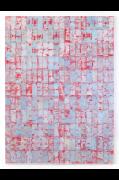Allora & Calzadilla, Cory Arcangel, N. Dash, Robert Janitz, Paulo Monteiro, David Ostrowski, Michael Rey, Julia Rommell, Dan Shaw-Town
When I was waiting in a bar, where were you? …
When I watched you from a distance did you see me? …
I want to find out about your life, do you like me?
Taking its title from a 1978 song of the same name by British punk band The Mekons, Lisson Gallery presents a group show of paintings, prints, relief objects and works on canvas that seem to require minimal intervention on the artists’ behalf, but actually belie the often extended periods of time spent contemplating, reworking or refining a process. Minimalism in art can take multiple forms and has been presented in many of its guises at Lisson Gallery over the decades, through exhibitions of Peter Joseph, Robert Mangold, Robert Ryman, Donald Judd and Sol LeWitt among others. Where Were You? focuses on the work of nine artists, five of which have not shown in the UK before, who articulate a minimalist aesthetic through abstraction, repetition or interruptions in surface and structure, foregrounding the intention, scale and execution of their gestures as both subjects for their work and as performative records of actions or thoughts.
While Cory Arcangel issues instructions to Photoshop to create his Gradient pieces ("Blue, Red, Yellow", mousedown y=5750 x=8250 and so on) in the manner of a 1970s conceptual artist, the Los Angeles-based Michael Rey populates his shaped wall works with a flattened layer of carefully hand-modeled, painted plasticine ground: “The choice of this material began as an experiment,” says Rey, “but continues to reflect my personal anxieties about finitude.” Robert Janitz employs a mixture of oil paint and flour (and sometimes egg or wax) to obfuscate his own line, or as he puts it: “to conceal painting with painting to show painting”. N. Dash creates wall-hung assemblages that reflect the manner and matter of their creation, involving the tools and supports of traditional painting – jute, linen, oil, pigment, rabbit skin glue, stretcher – which nevertheless foreground the colouration and texture of the original source material, rather than the hand of the artist.
The large paintings by Julia Rommel seem to highlight their frames, perhaps having been stretched more than once, whereas in truth the main bodies of the canvas are often intensely wrought through a process of layering and erasure that she likens to a fight: “I’ve found myself taking elaborate steps to keep my own signature away. I still remain perplexed at my constant refusal of my own gesture, why I find it so excessive.” Allora and Calzadilla have collated used sandpaper sheets from construction sites around the world (Dubai, Egypt, Detroit, New York, Mexico, and Cuba) to create a gridded abstraction that represents both labour and delegation. The sheaths of stacked paper by Dan Shaw-Town have also been degraded through abrasion, folding and constant reworking, until left puddled on the floor. Paulo Monteiro fills entire walls with beautifully contingent constellations of objects and paintings, marked by his physical engagement or the necessity of their making, much as David Ostrowski starts each painting as if it were his first, or last, questioning the practice at every stage.
Where Were You?
Lisson Gallery, 52 Bell Street, London

Ad
Event has ended
This event ended on Saturday 23rd of August 2014
This event ended on Saturday 23rd of August 2014
Admission
Free
Free
Website
Tags:
Art
User Reviews
There are no user reviews
